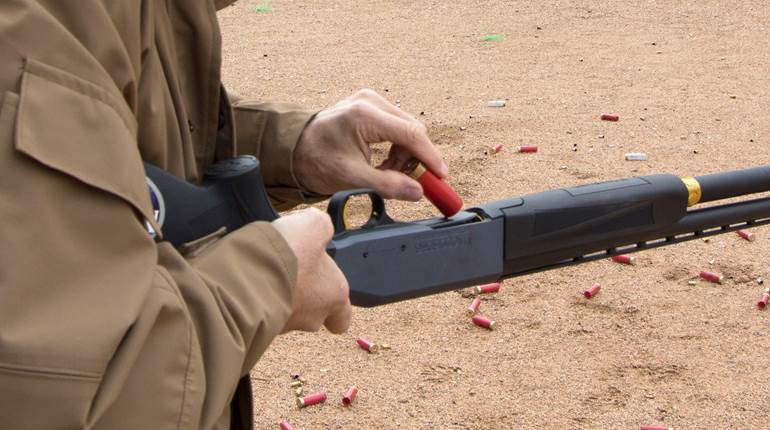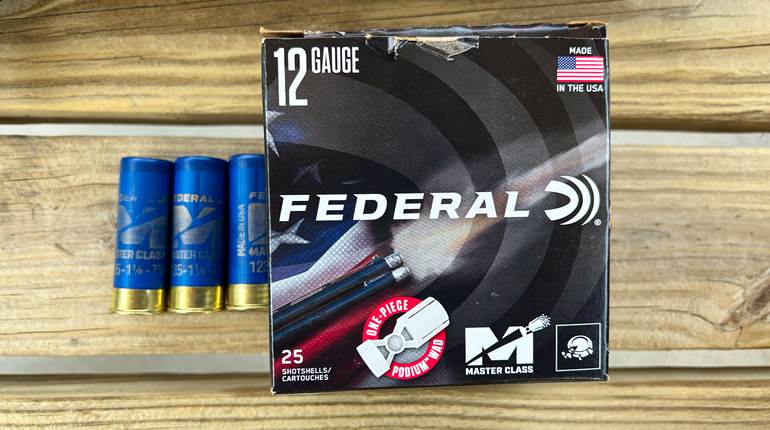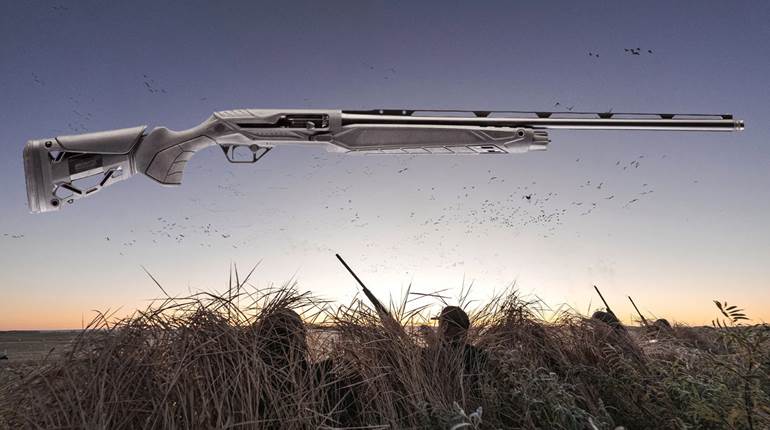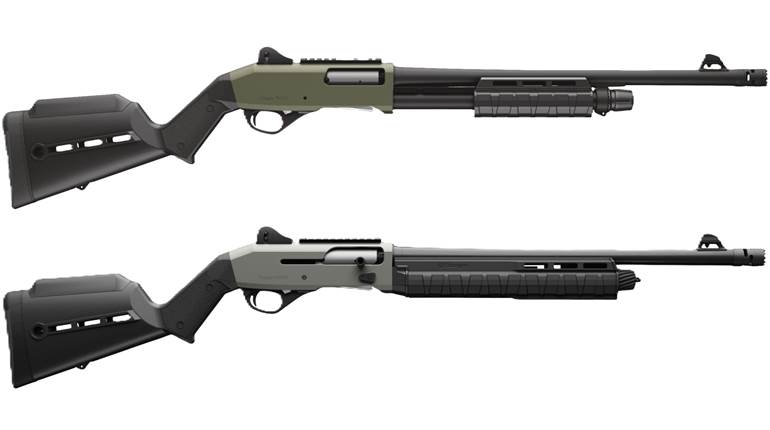
This article, "The Versatile 12 — The Long And Short," appeared originally in the July 2005 issue of American Rifleman. To subscribe to the magazine, visit the NRA membership page here and select American Rifleman as your member magazine.
Not Magnum, But Short
Few have seen—much less shot—a shotgun chambered for the cute little 2" shell. With the increased interest in side-by-side shotguns, some of these little guns are coming to the surface again. In the 1920s, when world economies were whirling along and British gunmakers were searching for “something new,” it was the 12 ga., 2", loaded with 7/8 ozs. of shot, just like the 20 gauge. In fact, these shotguns were advertised as being a 20 in 12-ga. clothes. Shotguns made for this squat little cartridge are feather-light, yet balance, handle and swing wonderfully; like a full-fledged 12. Although not many of these shotguns were made, the chances of finding one of these little 12s are increasing, and some Spanish gunmakers will chamber a custom shotgun for the 2" shell. Two-inch ammunition is imported by Fiocchi and Kent, and it is loaded in New Hampshire by RST, Ltd., as well.
British Standard

In Britain, the standard 12-ga. cartridge is the 2 1⁄2", loaded with one or 1 1⁄16 ozs. of shot. With the resurgence of interest in side-by-sides, more and more British-made shotguns are coming to these shores, and ammunition importers are obliging with matching ammunition. The British revel in shooting “high pheasants,” most of which are within 40 yds., and 21⁄2" shells excel at this range. Let’s face it, 35 yds. is 105 feet, and a 100-ft. tree is a very tall tree indeed, so we’re not talking long range. Shotguns are short-range affairs anyway, and shots over 40 yds. are questionable—statements from writers notwithstanding. Two-and-a-half-inch shotgun shells are available and fun to shoot. Their recoil is mild, although their velocity is equally mild, that’s not all bad. These shells generate low chamber pressures, so they are not only mild on the shoulder, but equally mild to your shotgun. Baschieri & Pellagri (B&P) uses a patented case design in its 2 1⁄2", 12-ga. and other loads called the Gordon-System case, which incorporates a shock-absorbing, internal basewad that reduces the felt recoil of these loads even further. Once an oddity, 2 1⁄2", 12-ga. shells are now more prevalent on dealers’ shelves and not at all difficult to obtain.
No American Standard
As shotguns evolved in this country, chambering was anything but standard. Provided you would order a case or two of shells—a case of shells in those days was 500—ammunition manufacturers would custom load whatever you wanted, as long as it was safe. These loads ran the gamut in length and strength from quail loads using very soft dropped shot to exotic duck loads made up for a particular club. During this golden age little was standard, so variations abounded. I recently bought a silver-worn but solid stub-Damascus-barreled Parker hammer gun that appears to have spent its life on Maryland’s Eastern Shore. When I attempted to put a set of Briley 20-ga. Companion Tubes in the barrels, they wouldn’t go, so I checked the chamber lengths with my Galazan chamber gauge, and I found my Parker—like so many shotguns of its era—was chambered for 2 5⁄8" shells. Briley honed out the barrels and made a set of 20-ga. tubes that corrected the problem and made a great shooter out of it, but this points up the fact that although in common use before that date, it wasn’t until the mid 1920s that 2 3⁄4", 12-ga. chambering and shells became truly standard. According to Model 12 expert Dave Riffle’s book The Greatest Hammerless Repeating Shotgun Ever Built, the first Winchester Model 12s, when released to the public in 1912, were all 20-ga. guns with 25" barrels, and chambered for 2" shells, the earliest 16-ga. Model 12s were chambered for the 29⁄16" shell, although 12-ga. Model 12s were 23⁄4"-chambered guns from the start. Regardless, it wasn’t until 1925 that 2 3⁄4" became the common chambering for all gauges of Model 12s.

The Standard, Really
Today, the 2 3⁄4", 12-ga. shell is the common denominator. Throughout this chamber length can be found ammunition for virtually any application one can imagine. On the mild end, we have subsonic rounds that have a velocity of less than 1000 f.p.s. designed as trainer loads for slightly built shooters, women and children, and for gun clubs where noise is an issue. These loads are highly effective for skeet, and I wouldn’t hesitate to use them for close-in doves and bobwhite quail. Loaded by Winchester, Fiocchi and Federal, recoil and—to a lesser extent—the report from these subsonic loads is virtually nonexistent.
Stepping up in velocity we enter the widest range of available 12-ga. loads; those of 1150 to 1200 f.p.s. velocity loaded with one to 1 1⁄8 ozs. of shot. Perhaps the very best of these target and field loads are the premium skeet, trap and sporting clays loads. These are assembled using the very best components and the hardest shot. Lead shot deforms at several points when it is fired through a shotgun. The first opportunity comes when the ignition of the powder thrusts the bottom of the shot charge against the static top portion of the shot column. Called setback, many of the lower pellets are crushed at this point. Although well protected by today’s plastic shotcups as they go through the bore, some pellets are still jostled, crushed and flattened. Finally, as the shot column goes through the choke, the squeezing of the charge causes further deformation. These deformed pellets either lag behind the shot string or more likely fly off at a radical angle and are lost from the effective pattern. Consequently, the harder the pellets, the less deformation takes place and the more round pellets remain in the pattern.

Because of all the advancements—wads with crushable setback softening sections and plastic shot cups, buffering and hard shot—made to current ammunition, choke is less necessary than most think. The sole reason for choke is to keep the maximum number of pellets within the pattern and, when introduced, it was a revelation to shotgunners whose loads of the day had none of the shot-protecting features we enjoy today. Steel shot, the pellets of which are hard as a rock, need virtually no choke to ensure good patterns. Hard lead pellets combined with shot cups need very little choke at game shooting ranges, and only when shooting handicap trap, the second shot on trap doubles, Olympic bunker or pigeons are the game does full choke come into play. Pigeon shooters like extra-tight chokes, but the hunter out to bag a couple of pheasants or a limit of doves really doesn’t need much choke. Improved cylinder is universal and modified tight enough for all but extreme situations.
When small shot is dictated, No. 7 1⁄2, No. 8 or No. 9, premium target loads are as good as you can get, but if you want a little edge on close doves or game-farm birds, look at the “el cheepos” sold by the marts. Most of us have bought a couple of boxes of these, which the ammunition industry calls “promotional loads.” Promotional loads are routinely loaded with 1 oz. of relatively soft shot kicked along at a fairly high velocity; somewhere around 1300 f.p.s. Because of their softer shot and higher velocity, these loads provide fairly wide patterns that give the average hunter a little advantage in the need for slightly less lead, and a wider pattern for the game to fly into.
Plating of shot is often interpreted to mean that the plating imparts extra hardness. Plating is very thin, and unless it’s applied over very hard lead pellets, it’s no more effective than the pellet to which it’s applied. Historically, the reason for plating was to prevent hot propellant gasses that had seeped past the card and felt wads from fusing pellets. However, copper and nickel plating do provide some benefits, and hence are worth the extra cost of ammunition loaded with them. Pigeon shooters often insist on shooting nickel-plated shot because it patterns better through extra-full chokes. Plating imparts a slipperiness to pellets, and they tend to flow better through tight chokes. They also tend to deform less when grinding against each other. Copper and zinc plating applied to steel shot is intended solely as a rust preventative.
One of the more important developments in shotshells has been the application of buffering to high-performance loads. Buffering material is ground plastic, and when sifted into and bedded around the pellets of any load, it helps to protect the pellets against deformation. Not to be casually used in any load, buffering changes the dynamics and weight of the shot column, and must be compensated for in the ballistic formula.

Heavy Field Loads
Along with these lighter loads come the 2 3⁄4" heavy field loads and short or baby magnums. These loads are the familiar pheasant loads, and before the mandate of non-toxic shot, were the common duck load across North America and Canada. Heavy field loads contain 1 1⁄4 ozs. of shot traveling at 1250 f.p.s. In recent years, the original 3" magnum load of 1 3⁄8 ozs. of shot with an initial velocity of 1350 f.p.s. has been duplicated in the 2 3⁄4" hull, and these are great loads for tough, wild pheasants.
As a youngster, I always knew when it was November because my dad always brought home a new box of 2 3⁄4" No. 6 Remington Express for the year’s pheasant and rabbit hunting season that opened on November 11. More game has probably fallen to that load than any other. But true to the American psyche, we want bigger; bigger burgers, golf clubs with heads the size of a 1955 Cadillac, and big magnum shotshells.
When the 3", 12-ga. magnum was introduced in the late 1920s, it was hailed as a real game getter. The first commercially loaded 3" magnum was the Western Super X, and it packed a slightly heavier payload, 1 3⁄8 ozs. of shot, at a higher velocity, 1350 f.p.s., than the existing heavy field load of 1 1⁄4 ozs. of shot at about 1250 f.p.s. These first magnums were fast, and with the addition of an extra 1/8 oz. of shot, patterns were more dense. The additional shot helped compensate for the loss of pellets through deformation. But, because bigger is better to we Americans, the magnum’s payload began to grow and grow, first to 1 5⁄8 ozs. and finally to 1 7⁄8 ozs. Now, rather than a fast, efficient load, the 3", 12 gauge became a bloated, slow round that punished the shooter with heavy recoil. When steel shot came along we wanted even more.
Time For A Change
When the government decided that all waterfowl had to be hunted exclusively with non-toxic shot, the only material available was steel. Rather than being melted and dropped through a sieve as lead shot is made, steel shot begins life as soft-iron wire, from which specific lengths are snipped. These are then heated to anneal them and then rolled into pellets. Although they begin as soft iron and are annealed, steel shot is still many times harder that lead shot. In addition, it’s about two-thirds as heavy as lead, making it much less ballistically viable downrange. In order to ensure some equivalency with lead, it was determined that selecting pellets one size larger would provide comparable downrange performance. Therefore, if one traditionally shot the common duck load of No. 4 lead shot, he needed to choose No. 2 steel shot. Goose hunters found that even larger pellets were necessary, and steel pellets in BB-, BBB-, T- and F-size pellets became common fare in blinds. In order to ensure dense enough patterns with these very large pellets, an even larger case was needed.
Bigger And Just Big
Because of its large case capacity and larger bore diameter that better handled large pellets, the 10 gauge enjoyed a dramatic rebirth, but, because the 10 was so limited, shotgun and ammo manufacturers sought something more versatile.

In 1988, the Federal Cartridge Company and O. F. Mossberg & Sons entered into a collaborative effort that resulted in the introduction of the 3 1⁄2", 12-ga. magnum cartridge and the Mossberg 835 UltiMag pump. This new 12-ga. round provided room for all but 1/16-oz. less shot than the 10 gauge, yet allowed the owner to shoot every other 12-ga. shell—real versatility for the one-gun man. Today, 3 1⁄2"-chambered 12s abound and, like the 3" magnum, have increased the payload into ultra-heavy loads of 2- and 2 1⁄4-ozs. of lead shot for turkey, and 1 9⁄16-oz. loads of steel shot.
No shotshell, no magnum will compensate for poor marksmanship, and although the increased two- and 21⁄4-oz. payloads may make sense for turkey, and to a small degree did when we shot unprotected lead shot, with hard steel shot there may not be a real good reason to shoot these super-long magnums. Certainly these shells have more shot, but at the penalty of a lower velocity, and it is increasingly clear to me that for ducks and geese that are in steel-shot range, 2 3⁄4" and 3" shells are more than adequate. When shooting the new breed of non-toxics, such as Remington’s Hevi-Shot and Federal’s Heavy Weight Mag-Shok—for which outlandish claims of long-range kills are made, mega-magnums seem even less necessary due to the increased density, and hence lethality, of the shot.
Count Your Blessings
Shotshells have come a long way since the turn of the 19th century when breechloading and repeating shotguns were still relatively new. Loaded in cardboard tubes that swelled in wet weather and filled with inconsistent powders, corrosive primers and wads that allowed hot propellant gasses to seep past them and fuse pellets, combined with rolled crimps that skewed patterns, these early loads were nowhere near those we enjoy today. Plastic hulls are weatherproof—some sealed completely against moisture; primers and powders are so good that sub-standard loads don’t exist; non-corrosive primers protect bores from rust and pitting; and crimps are carefully engineered for maximum pattern performance.
In short, today’s shotgun ammunition is fundamentally state-of-the-art, and everyone ought to be grateful that it is such an easy task to simply go to their local gun shop and pick up a box of shells knowing that they will perform.
You Still Have To Shoot It
Recoil is an important aspect of shell selection. In his definitive book, The Gun And Its Development, the well-known gunmaker W.W. Greener states that to be comfortable to shoot, a shotgun needs to be 96 times as heavy as the shot charge being shot. A minute spent with a calculator shows us that a 1-oz. charge of shot requires a shotgun of no less than 6 lbs. (96 divided by 16 equals 6) to be comfortably and repeatedly fired. If we move up to one of the relatively new 3", 12-ga. magnums shooting 2 ozs. of shot we need a 13 1⁄2-lb. shotgun to adequately slow the recoil from one of these mega-magnums. So while the current crop of 3" magnums may appeal to the “bigger is better” American psyche, lighter loads often prove more user friendly, since less recoil translates to better marksmanship.
















![Auto[47]](/media/121jogez/auto-47.jpg?anchor=center&mode=crop&width=770&height=430&rnd=134090788010670000&quality=60)




















